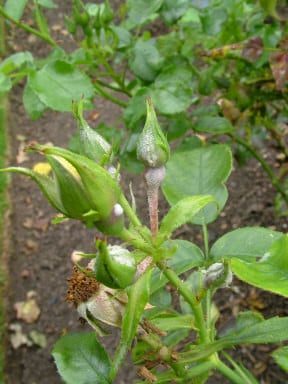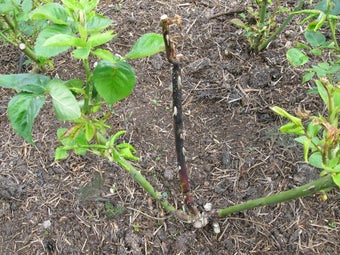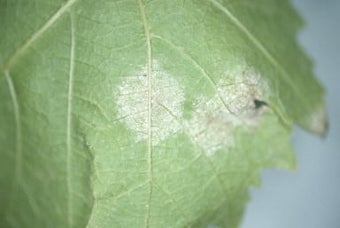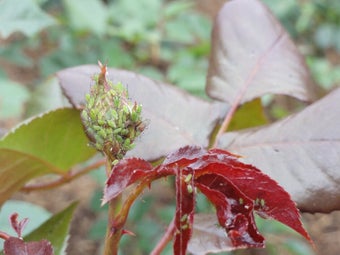
Quick facts
Common name - Rose powdery mildew
Scientific name - Podosphaera pannosa
Plants affected - Roses
Main symptoms - White, powdery fungal growth on leaves and other aerial parts
Caused by - Fungus
Timing - Summer
What is rose powdery mildew?
Rose powdery mildew is a disease of roses caused by the fungus Podosphaera pannosa. The conspicuous white growth can affect all aerial parts of the plant, producing microscopic spores that spread the disease. High humidity is favourable for infection, and plants growing in areas where air movement is poor or the soil is dry can be severely affected.
Symptoms
You may see the following symptoms:
- A white, powdery fungal growth on the leaves and shoots. Upper, lower or both leaf surfaces can be affected
- There may be discolouration (yellow, reddish or purple) of the affected parts of the leaf, and heavily infected young leaves can be curled and distorted
- Mildew growth may also be found on the stems, flower stalks, calyces and petals
- Heavily infected flower buds frequently fail to open properly
- Mildew growth on stems (where it is often found surrounding thorns) and flower stalks is usually thicker and more mat-like than that on the leaves
- The mildew growth on all parts may turn browner as it ages

Control
The RHS believes that avoiding pests, diseases and weeds by good practice in cultivation methods, cultivar selection, garden hygiene and encouraging or introducing natural enemies, should be the first line of control. If chemical controls are used, they should be used only in a minimal and highly targeted manner.
Non-chemical control
Manage the environment around susceptible plants:
Choose the best location
- Plant in full sun where possible (the exception is shade-loving plants)
- Climbers and ramblers grown in situations with good air circulation (e.g. over arches, rope swags or pergolas) are less likely to be affected than those grown in still air (e.g. planted closely against walls, in sheltered corners, etc.). Bush roses grown in sheltered situations are also more likely to be attacked
Manage the soil
- Provide good drainage, but water regularly during dry periods (plants suffering from regular but intermittent drought-stress are more susceptible). Application of mulch may help water retention
- Feed regularly to encourage strong growth, but avoid using too much nitrogen – this produces ‘soft’ growth which is prone to attack
Manage humidity and leaf wetness
- Don’t plant too densely, giving space between plants. Aim for an open environment to increase air circulation and reduce humidity
- Prune shrubs to give an open structure (which will improve air circulation and reduce humidity)
- Avoid overhead watering early in the morning or in the evening
- Overhead watering (in mid-morning) in dry weather can reduce powdery mildew (which does not like direct contact with water). Avoid leaves remaining wet for long periods, however, as this may favour other diseases such as black spot and rust
Badly affected shoots are best pruned out and disposed of as soon as the symptoms are seen. During routine spring pruning any shoots showing large patches of mildew around the thorns should also be cut out
There are considerable differences in susceptibility between rose cultivars. However, any claimed resistance to the disease may not persist for the lifetime of the plant, or be effective in all localities.
Fungicides
The RHS recommends that you don't use fungicides. Fungicides (including organic types) may reduce biodiversity, impact soil health and have wider adverse environmental effects. If you do intend to use a fungicide, please read the information given in the link and download below to ensure that use, storage and disposal of the product is done in a responsible and legally compliant manner.
The products listed in the ‘Fungicides for gardeners’ document below are legally available for use by home gardeners in the UK. This information is provided to avoid misuse of legal products and the use of unauthorised and untested products, which potentially has more serious consequences for the environment and wildlife than when products are used legally. Homemade products are not recommended as they are unregulated and usually untested.
Download
Fungicides for gardeners (Adobe Acrobat pdf document outlining fungicides available to gardeners)
Link
Biology
Rose powdery mildew spreads during the growing season by means of microscopic, air-borne spores produced on the powdery growth. Unlike many other fungal diseases, extended periods of leaf wetness are not required in order for the spores to germinate. This means that powdery mildew is often a problem during dry summers.
High humidity is, however, favourable for spore production and infection, and plants growing in areas with poor air flow (allowing the accumulation of humid, ‘stagnant’ air) are likely to be attacked. Thus climbers and ramblers grown against walls and fences are often heavily infected.
Rose mildew overwinters as fungal growth (mycelium) on the stems, or within some of the dormant buds. When these buds resume growth in spring the shoots soon become completely covered with mildew. The fungus then spreads from these infected shoots (known as ‘primaries’) onto the rest of the plant.








